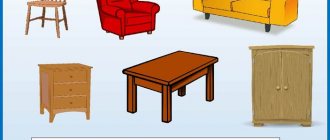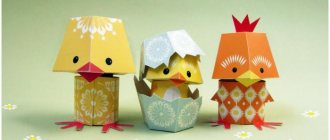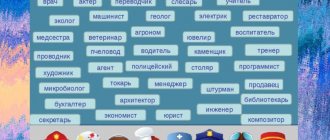Long-term planning “The world around us”, second junior group.
Let's all get up guys and warm up a little.
Physical education minute.
Q: How do fish differ from each other? Let's tell Mishka.
D.: Color, shape, size, habits, nutrition, name, habitat. Coloring helps fish hide from predators, they have different names, different body shapes, large and small sizes, have different habits...
Q: What do fish eat?
D: Fish eat fish and aquatic plants.
Q: Where do fish live? Can fish live without water? In what bodies of water do fish live? Can fish live in a swamp?
D.: Fish live in water, fish cannot live without water. They live in a river, lake, pond, sea, ocean. Fish cannot live in a swamp; the water there is dirty.
V.: The habitat of fish is the same, it is water, but fish are divided into different species. What types of fish are divided into?
D.: River, sea and aquarium.
Q: Why are fish called river fish? Why sea? Why aquarium?
D.: River fish live in fresh water, sea fish live in sea salt water, aquarium fish live in clean water - in an aquarium.
V.: River and sea fish are free-living and lead an independent lifestyle. Can aquarium fish live on their own? How should you care for them?
D.: Aquarium fish live in an aquarium and need human care and attention. It is necessary to change the water and feed the fish with special food.
Q: Guys, tell me, are fish only adults? What is a baby fish called? What do fish come from?
D.: Fish are also born small, the baby is called a fry, tadpoles hatch from eggs, grow and turn into small fish, grow, becoming adult fish.
Game “Name it kindly.”
(Head, tail, fin, scales, body).
Each part of the fish’s body must be named affectionately. I will tell you any part of the fish’s body, and you name it to me in an affectionate manner.
D.: Head, head, tail, scale, scale, fin, body.
Why do people say “Pisces are children of water”?
D.: Fish are born in water and live their entire lives in water.
Part 3: final.
V.: Well done guys, you completed all the tasks!
What did we talk about in class today? What did we teach Mishka?
D.: Today we taught Mishka how to recognize fish and not confuse them with other animals.
V.: Well, now, Mishka, do you understand how to recognize fish and not confuse them with other animals?
M.: Yes, guys, now I understand everything. Thank you for your help!
V.: Please, Mishka, come to us again, we will teach you a lot.
Did you guys enjoy the activity? Well done everyone! Thanks to all!
Appendix No. 4
Victory Day"
Target:
Expand children's knowledge about the Great Patriotic War and Victory Day. To develop the ability to respect the heroism of our soldiers. To instill in children pride and respect for WWII veterans, monuments dedicated to the Second World War, and a sense of pride for the Motherland. To develop in children imagination, observation, curiosity, and the desire to learn more new, useful, and interesting things. Development of memory, attention, speech, thinking.
Notes on the world around us for the younger group in kindergarten. Pets and their babies
Summary of a lesson on the surrounding world for younger preschoolers “Pets and their cubs”
I present to your attention a summary of a lesson on the surrounding world for teachers of the 2nd junior group on the topic “Pets and their cubs”. The lesson is designed for children 3-4 years old. I conducted this lesson with children at the beginning of the week on the lexical topic “Pets”, in the morning, the lesson lasts 15 minutes. Goal: to introduce children to domestic animals and their cubs. Objectives: 1. learn to name pets; 2. teach to compare animals by size; 3. develop memory, love for animals; 4. develop attention and speech; 5. activate and enrich your vocabulary. Planned result: 1. be able to guess riddles based on verbal descriptions; 2. teach how to look at illustrations; 3. be able to talk about what is shown in the picture. Progress of the lesson: Educator: Hello, guys. Today different animals came to visit us. (on the magnetic board there are images of animals: cow, cat, horse, dog) Listen to the riddles and try to guess the names of the animals. Riddle 1 - She has horns, hooves, and looks angrily at everyone. But she is kinder than a puppy, and will pour us milk. Children: Cow . Educator: Well done guys, that's right, cow! (I show a picture of a cow). I say that the cow has what on its head? - Horns, eyes, ears, mouth. The cow chews grass and gives milk! Riddle 2 - He’s crying at the threshold, hiding his claws. He will quietly enter the room, purr, and sing. Children: Cat, cat. Educator: That's right, cat. (I show a picture of a cat) I say that a cat has ears, eyes, a nose, a mouth and whiskers on its head. The cat catches mice, it is pleasant to stroke its fur. Riddle 3 - I have a big mane, ears and hooves. I'll give him a playful ride, who isn't afraid. My fur is smooth, Who am I?... Children: Horse . Educator: That's right, guys. (I show a picture of a horse). I say that the horse has a mane, tail and hooves. You can ride a horse. Riddle 4 - Lives in the yard, In a private house-kennel, And at everyone she doesn’t know, She either growls or barks. Children: Dog . Educator: Dog, well done guys. (I show a picture of a dog). I say that the dog has 4 legs, a tail, and ears. A dog is a person’s friend, it guards the house, you can go hunting with it. Educator : Well done, guys, you guessed all our guests. What can you call all these animals? What are they? Children: Homemade Teacher: Why are they called homemade? Children: Because they live in the house and in the yard. Educator: That's right, guys. And I also have pictures of their cubs. The only problem is, they are all mixed up. Let's try to give each animal its own baby, shall we? Educator: The dog has a small... puppy
.
Katya, go to the board and take the little puppy to your mother. (the child attaches a picture of a puppy to a dog). And the cat has a small... kitten
.
Olya, go to the board and help the little kitten find its mother. (the child attaches a picture of a kitten to a cat). The cow has a small... calf
.
Sasha, come out and take the little calf to your mother. (the child attaches a picture of a calf to a cow). The horse has a small... foal
.
Seryozha, go to the board and help the little foal find its mother. (the child attaches a picture of a foal to a horse). Educator: Guys, tell me, do you know how animals take care of their young? They feed them milk, clean their fur with their tongue, protect and warm them. How do animals take care of their young? Children: repeat the teacher’s answer. Physics minute “Kitty”: Here’s a kitten, sneaking around in a circle, one after another on its tiptoes.
Round face,
stop, show the face with both hands, shake their head.
And on each paw
they rhythmically extend their left hand, then their right.
Scratchy claws.
All his toys are jumping on their toes, holding their hands on their belts.
Cube and reels.
The cat, like a ball, bounces and moves in a circle one after another.
Jumps around the apartment.
Game "Feed the animals" . A kitten and a puppy are sitting on the table. Educator: Guys, tell me, what do you think the kitten likes to eat? Children: milk, sour cream. Educator: That's right, guys. I invite one child to bring a toy plate, another to “pour” milk from a bottle, and a third to place the plate near the cat. Guys, what do you think the puppy likes? Children: bones, bread. Educator: Good guys, guys. Let's feed our puppy too. I suggest feeding him a bagel. Educator: The kitten and puppy ate and went to bed. And it's time for us to finish our lesson. Guys, tell me what animals we saw in the pictures? What are their cubs called? Who did we feed and put to bed? What did you feed? Why are our guests called pets?
We recommend watching:
GCD summary in the 2nd junior group on the topic “Friends for the Snowman” GCD summary for mathematical development in the first junior group GCD summary for the development of cognitive abilities in the first junior group
Similar articles:
Summary of an integrated lesson in the 2nd junior group
Abstract of educational activities on cognitive development in the junior group of preschool educational institutions
Summary of a developmental lesson in the educational field of cognition in the second junior group of kindergarten on the topic: “The world around us”
Compiled by teacher of group No. 1 Tatyana Adamovna Volkova.
Goal: formation of primary ideas about the world around us. Objectives: educational: to cultivate politeness and the ability to work in a group. Developmental: develop the ability to coordinate your actions with the actions of others, develop thinking, attention, memory, fine motor skills, constructive skills. Educational: Speech development . teach to understand general words, develop and enrich children’s vocabulary through words denoting trees, properties of water and sand. Sensory development . Fix the color, size and shape of objects. FEMP. Distinguish between the concepts many, one, none, understand the questions: “Is it equal?”, “What is less (more)?, compare objects by size, determine the shape of objects, examine the shape of objects using vision and touch. Distinguish between right and left sides. Introduction to the natural world . Expand children's understanding of plants and animals, clarify their understanding of the properties of water and sand. Ecological culture. Review the rules of behavior in the forest. Constructive-model activity . Learn to build the simplest three-dimensional buildings using a magnetic construction set. Game activity: help enrich the gaming experience. Physical development : develop activity in motor activity, develop various types of movements. Develop fine motor skills of the hands. Musical development. .Cultivate emotional responsiveness to music. Preliminary work. Getting to know wild and domestic animals, playing games and watching presentations on this topic, reading fiction on relevant topics, experimental activities with water and sand. Materials: carpets, images of wild, domestic animals, birds, magnetic board, images of trees, magnetic construction set, animal toys, interactive guide “Sun”, colorful birds, pebbles, sand, material for the river, narrow and wide bridges, wall game “Mosaic” ", toys for playing with sand. Illustrations with rules of behavior in the forest. Star stickers, presentation with video of a meteor shower, a falling star, a flying star, recording the sounds of laughter, birdsong, the sound of a river. The world around us .
Move:
Greeting guests. Greeting each other : all the children have gathered in a circle, you are my friend and I am your friend, we will hold hands tightly and smile at each other. Today I want to show you one interesting phenomenon. Slide show “Meteor shower, shooting star” Would you like a star to come to us? The sound of laughter is heard . I wonder who's laughing, let's go and see. (children follow the sound of laughter and find a star, say hello) This star has flown from another world and she really wants to know what is interesting in our world. Who lives in our world? (animals and birds) What kind of animals do we have (wild and domestic) Working with carpet (game “ Do it right” (to the left of the tree are domestic animals, to the right are wild animals, on the tree are birds) Let’s let's play with the birds. They are not simple, but magical, because it’s as if you will turn into these birds: spin around yourself and turn into a bird. Game “Birds of different colors ) Turn into children again: spin around yourself and turn into children. And we will continue to tell the star about our animals. Where do domestic animals live:? (near a person, a person takes care of them and builds houses for them.) Let us also build houses for our animals. Playing with a magnetic constructor . How many square pieces do you have? (4), how many triangular parts do you have? (4) Which parts have more? (as many square, as many triangular, equally) We built houses for domestic animals, but where do wild animals live, who builds houses for them? (Wild animals live in the forest and build their own houses) Let's check if we decided correctly, Let the star take a look. Interactive game “Sun” You said correctly, wild animals live in the forest. What is a forest? (this is a place where there are a lot of trees and bushes) Here we will have a forest (we approach the magnetic board. How many trees are there? (none) Let’s make a forest and grow a lot of trees here. What trees do you know? Children name the trees and place them them on a magnetic board. And besides animals, who else can live in the forest? (birds) Let’s feel like we’re in a forest: turn around and find yourself in the forest. Let’s listen to the birds sing (sounds of the forest) Let’s remember the rules of behavior in the forest .(showing prohibition signs) Let's take a little walk through the forest. (Recitative warm-up) The children walked through the forest, watched nature, looked up at the sun, warmed their faces, raising their shoulders, grasshoppers were jumping, butterflies were flying, flapping their wings, raise your legs higher. You and I went to the river (the children turn and see the river that appears on their way) Asterisk, we also have lakes, rivers, seas and oceans. And what is a river, let’s tell the asterisk. (There is water in the river ,) And what kind of water can it be (transparent, warm, cold, water pours, runs) The little star saw something beautiful on the other side, what is it. (these are flowers) That's right, there are still flowers in our world. Let's cross the river and see the flowers. How can we cross the river? (on the bridge) Look, there are two bridges here. One (wide) and the other (narrow), I will walk along the wide bridge, and which one will you:? (children cross the river and approach the picture of flowers). What color are these plants? (red, yellow, blue,) And which flower is higher? Below? Well done, they showed the star the flowers, and what else is there in the river and on the shore (pebbles, sand, and fish) Let's collect the pebbles. Hand massage: I roll a pebble in my hand, I move it back and forth, I stroke my palm with it, as if I were sweeping up crumbs and I squeeze it a little, like a cat squeezes its paws, I open the pebble and start rolling again. We showed the little star how hard they are. Now let's show her the sand. What kind of sand is there (dry - crumbles and wet - molds). Here we have sand and pebbles, what’s missing? (fish) Let’s make it look like a river bottom here: we’ll sculpt fish and decorate the bottom with pebbles. Working in the sandbox. That's how beautiful it turned out. The star really liked it. And what is shining above all this? (the sun) And here is the sun, what is it missing? (rays) Let's make some rays for it so that the star can see how beautiful it is. Game with clothespins. The star really liked it with us, she will definitely tell other stars about everything. It’s time for her to fly away, and as a souvenir she leaves you these stickers - stars. Farewell to the star. View the slide “The star disappears” It’s time to return to the group: one, two, turn around, and you’ll find yourself in the group. Reflection. In front of the children is a drawing with a landscape, the children remember who they told the star about and place images of animals, birds, a tree, a river, the sun, pebbles on the landscape.
We recommend watching:
Summary of a game (integrated) lesson on environmental education for the 2nd junior group. A summary of the GCD in the junior group on traffic rules. A synopsis of the GCD on social and communicative development for the 2nd junior group. A synopsis of the GCD for physical education in the second junior group.
Similar articles:
Lesson summary for an early age group. Vegetables: turnips and carrots
Lesson summary for an early age group. Vegetables: beets and potatoes
Lesson summary for an early age group. Fruits: lemon and orange
Lesson summary for an early age group. Cat with kittens
Summary of a lesson in an early age group on a winter theme. Hare and fox
Natural and man-made world. Lesson on familiarization with the objective world in the 2nd junior group
Familiarization with the objective world in the 2nd junior group Topic: “Natural and man-made world” Program content:
- Introduce children to the natural and man-made world.
- Encourage children to compose stories about nature using an algorithm.
- Define a generalizing word for a group of objects.
- Strengthen children's knowledge about the time of day.
Progress of the lesson: Children enter like a train - hold hands. - Stand around me, everyone. So we slept today, woke up, and what happened? (morning). Did you watch TV today? But I was listening to the radio, and you know what happened? (I stand at the table, take the microphone and speak in the voice of an announcer): - Attention, attention! There are two types of things missing: natural and man-made. Man-made - things made by man himself! Natural - created by nature. If anyone finds the items, please return them to their destination. (I leave the table). This is what they said on the radio today. Let's help you find things. Look, we have some things scattered around our group. Find and bring one item at a time. (children take pictures from the floor). Sit down on the chairs, we'll sort things out now. On one table there are things that are man-made, and on the other, things that are natural. - Attention attention! This thing that has sleeves, a fur collar, what is it? (fur coat), who made it? (man), what table will we put it on? (man-made world). - Attention! We need to find a small, beautiful one, with wings! Who is this? (butterfly) On what table? (natural). - Attention! You need to find leather ones, they put them on your feet, they have laces! What are these? (boots), did nature create them? Human. - Attention! You need to find something tasty, rosy, juicy, very tasty, it contains a lot of vitamins! This Apple). Who created it (nature). - Attention! You need to find a soft, fluffy one, he has 4 legs, loves milk very much, who is he? (pussy), is this the natural or man-made world? (natural). - Attention! You need to find a berry, black in color, large, compote and jam are made from it, what is it? (black currant), who created it? (nature). - Attention! You need to find a wooden object, it has 4 legs and a back. What is this? (chair), who created it? (man). - Attention! You need to find a very tasty, long, green vegetable, what is it? (cucumber), who created it? (man). - Attention! You need to find a very beautiful, delicate one, butterflies love to land on it, it has white petals and a yellow center, what is it? (daisy). Who created it? (nature). - Attention! You need to find an object, it is very large, it has a bottom and 2 handles, you can cook soup in it, what is it? (saucepan). Who created it? (man). - Attention attention! Radio Arkhangelsk speaking. We thank everyone who took part in the discovery of objects from the natural and man-made world! Well done guys, you helped find lost things.




